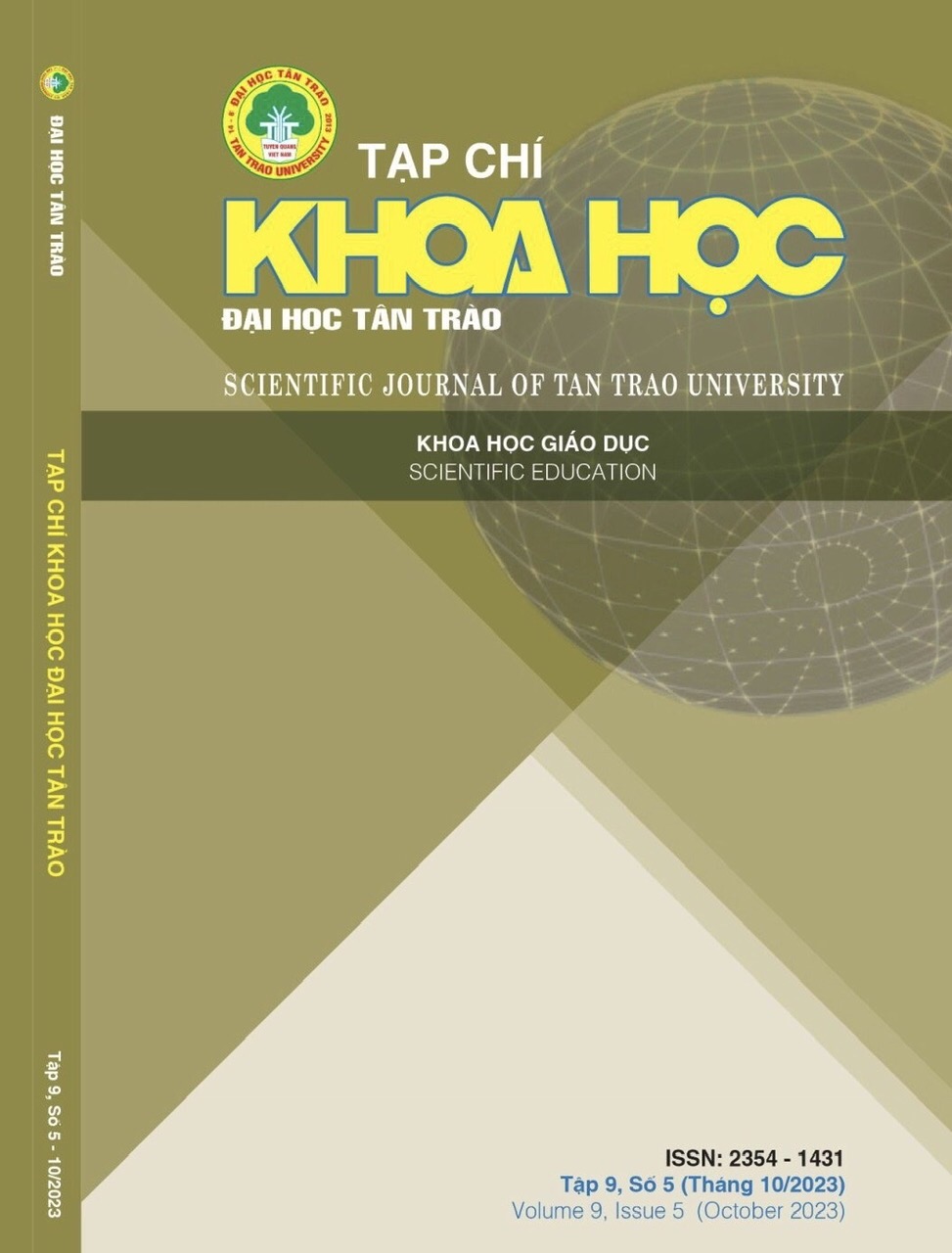VẬN DỤNG PHƯƠNG PHÁP DẠY HỌC PHÁT HIỆN VÀ GIẢI QUYẾT VẤN ĐỀ TRONG DẠY HỌC MÔN LÝ THUYẾT XÁC SUẤT THỐNG KÊ VÀ ỨNG DỤNG CHO SINH VIÊN TRƯỜNG ĐẠI HỌC TÀI CHÍNH – MARKETING
DOI:
https://doi.org/10.51453/2354-1431/2023/1035Tóm tắt
Lý thuyết xác suất và thống kê là môn học quan trọng trong chương trình đào tạo ngành Kinh tế. Tuy nhiên, nhiều sinh viên gặp khó khăn trong việc tiếp thu môn học này do tính trừu tượng và phức tạp. Bài báo này trình bày về việc vận dụng phương pháp dạy học phát hiện và giải quyết vấn đề nhằm nâng cao hiệu quả dạy và học môn Lý thuyết xác suất thống kê và ứng dụng cho sinh viên Đại học Tài chính - Marketing. Phương pháp này giúp sinh viên rèn luyện tư duy phản biện, vận dụng kiến thức vào thực tiễn và cải thiện kỹ năng giải quyết vấn đề. Kết quả nghiên cứu cho thấy phương pháp dạy học này giúp nâng cao hiệu quả học tập của sinh viên.
Tải xuống
Tài liệu tham khảo
[1] Garfield, J. & Ben-Zvi, D. (2008). Developing students’ statistical reasoning: Connecting research and teaching practice. Springer Science & Business Media. ISBN: 978-1-4020-8382-2
[2] Hmelo-Silver, C. E. (2004). Problem-based learning: What and how do students learn? Educational Psychology Review, 16(3), 235-266.
https://doi.org/10.1023/B:EDPR.0000034022.16470.f3
[3] Barrows, H. S. (1996). Problem-based learning in medicine and beyond. In L. Wilkerson & W. Gijselaers (Eds.), Bringing problem-based learning to higher education: Theory and practice (pp. 3-13). San Francisco, CA: Jossey-Bass.
https://doi.org/10.1002/tl.37219966804
[4] Strobel, J., & Van Barneveld, A. (2009). When is PBL more effective? A meta-synthesis of meta-analyses comparing PBL to conventional classrooms. Interdisciplinary Journal of Problem-Based Learning, 3(1), 4.
DOI:10.7771/1541-5015.1046
[5] Jacobs, A. E. (2007). An in-depth investigation of the purposes and utilization of problem-based learning within academic programs for occupations therapists and physical therapists in Victoria, Australia and Ontario, Canada (Doctoral dissertation, Drexel University).
DOI:10.1007/978-0-387-71164-5_4
[6] Hung, W., Jonassen, D. H., & Liu, R. (2008). Problem-based learning. Handbook of research on educational communications and technology, 3, 485-506. eBook ISBN9780203880869
[7] Jonassen, D. H. (2011). Supporting problem solving in PBL. Interdisciplinary Journal of Problem-Based Learning, 5(2), 95-119.
https://doi.org/10.7771/1541-5015.1256
[8] Savery, J. R. (2006). Overview of problem-based learning: Definitions and distinctions. Interdisciplinary Journal of Problem-based Learning, 1(1), 3.
https://doi.org/10.7771/1541-5015.1002
[9] Gallagher, S. A., Sher, B. T., Stepien, W. J., & Workman, D. (2010). Implementing problem-based learning in science classrooms. School science and mathematics, 95(3), 136-146.
DOI:10.1111/j.1949-8594.1995.tb15748.x
[10] Bransford, J. D., & Stein, B. S. (1984). The IDEAL problem solver: A guide for improving thinking, learning, and creativity. New York: W.H. Freeman. ISBN 0-7167-2204-6 (cloth). ISBN 0-7167-2205-4 (pbk.)
[11]. Van, N.C., Ninh, T.T.,Probability Theory & Mathematical Statistics Textbook, National Economics University Publishing House, 2008.
[12]. Van, N.C., i Ninh, T.T., Exercises in Probability & Mathematical Statistics, National Economics University Publishing House, 2009.
Tải xuống
Đã Xuất bản
Cách trích dẫn
Số
Chuyên mục
Giấy phép

Tác phẩm này được cấp phép theo Giấy phép Quốc tế Creative Commons Attribution-ShareAlike 4.0 .
Bài báo được xuất bản ở Tạp chí Khoa học Đại học Tân Trào được cấp phép theo giấy phép Ghi công - Chia sẻ tương tự 4.0 Quốc tế (CC BY-SA). Theo đó, các tác giả khác có thể sao chép, chuyển đổi hay phân phối lại các bài báo này với mục đích hợp pháp trên mọi phương tiện, với điều kiện họ trích dẫn tác giả, Tạp chí Khoa học Đại học Tân Trào và đường link đến bản quyền; nêu rõ các thay đổi đã thực hiện và các nghiên cứu đăng lại được tiến hành theo cùng một bản quyền.
Bản quyền bài báo thuộc về các tác giả, không hạn chế số lượng. Tạp chí Khoa học Tân Trào được cấp giấy phép không độc quyền để xuất bản bài báo với tư cách nhà xuất bản nguồn, kèm theo quyền thương mại để in các bài báo cung cấp cho các thư viện và cá nhân.
Mặc dù các điều khoản của giấy phép CC BY-SA không dành cho các tác giả (với tư cách là người giữ bản quyền của bài báo, họ không bị hạn chế về quyền hạn), khi gửi bài tới Tạp chí Khoa học Đại học Tân Trào, tác giả cần đáp ứng quyền của độc giả, và cần cấp quyền cho bên thứ 3 sử dụng bài báo của họ trong phạm vi của giấy phép.


